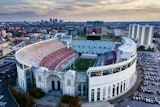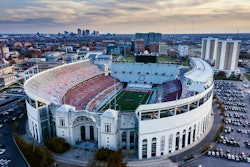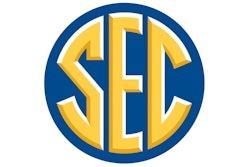Faulty stairs leading to a high school stadium's press box result in a reporter's death, multiple safety violations and a hefty fine.
More than six months have passed since a sportswriter for The Buffalo News died from head and neck injuries sustained in a fall at Buffalo, N.Y.'s Robert E. Rich All High Stadium. But repercussions of Tom Borelli's death are still emerging.
The 51-year-old reporter was on his way to cover a football game between Riverside and McKinley high schools on Nov. 8 when he reportedly hit his head while climbing the 13 metal, ladder-like steps that lead to the press box. (The steps terminate at a hatch, which visitors must prop open to access a walkway leading to the stadium's rooftop press box, which remains open today.) Borelli lost his balance on the stairs and plummeted to the concrete below. He died 12 days later.
State labor investigators have slapped Buffalo Public Schools with five safety violations involving the steps - which were installed when the stadium was built in 1926 - and gave administrators until July 18 to make improvements. Among the citations: overly narrow tread widths, substandard handrails, insufficient vertical clearance at the top of the steps, and no nonslip finish on the top step. At 59 degrees, the steps also are angled too steeply, the report says. "The hazard has existed long enough that through due diligence, the [district] should have known of the hazard," inspector Paul Shemkovitz wrote in his report.
Then, in April, the Occupational Safety and Health Administration (which requested the state labor investigation) chimed in with its recommendation that The Buffalo News - but not the school district - be fined $31,500 for knowingly sending Borelli into an unsafe working environment. In the paper's defense, a subsequent editorial stated, "That means news organizations should not ask their journalists to cover wars, fires, hostage standoffs, crimes in rough neighborhoods, anything involving air, sea or road travel - or high school football games in old stadiums. . . The fault rests with the condition of the stairway, not at the doorstep of this newspaper."
"Not only is this a bizarre OSHA fine, it could set a dangerous precedent," blogged Fred Hosier, editor of www.safetynewsalert.com. "Imagine being fined by OSHA because your employee suffered a work injury that didn't happen on your property."
While both the paper and the school district mulled appeals, the press box remained open. Buffalo Public Schools wrapped up more than $6 million in stadium renovations in 2006 (see "Good As New," January 2008, p. 72) but at that time eliminated a proposed elevator to the press box in a cost-saving move. "The press box is considered a building, just like any other building, and it should provide for the health, safety and welfare of its occupants, regardless of its size," says Derek Webb, a designer and project manager with M Architects in Houston, which last year won an award for its design of Scotty Caven Field's press box at St. John's School in Houston.
Although it's easy to overlook structures that might take up less than 150 square feet of space, press boxes should be subject to regular building inspections and given the same attention as other parts of an athletic facility, Webb says. Specifically, facility operators should consider ease of access to the structure and ensure that occupants can exit the press box effectively in an emergency situation.
Margaret M. Sullivan, editor of The Buffalo News, told readers that her reporters never were required to cover games from All High's press box, adding that they've been encouraged to "steer clear of the stairs until changes to them are made."




































